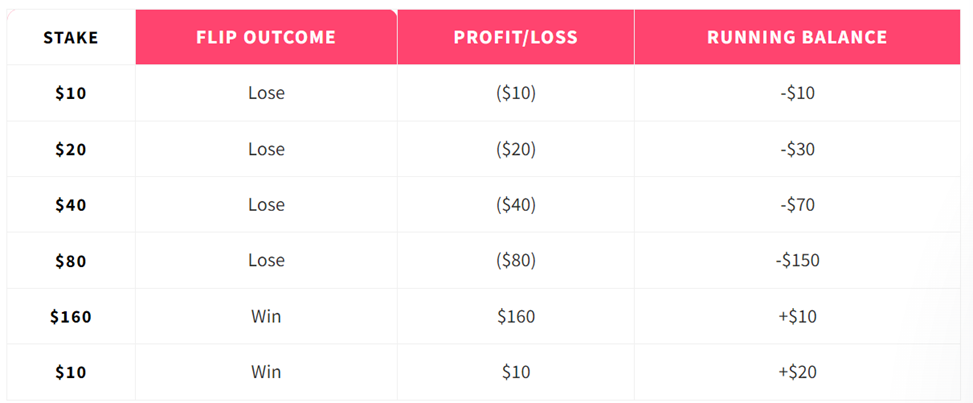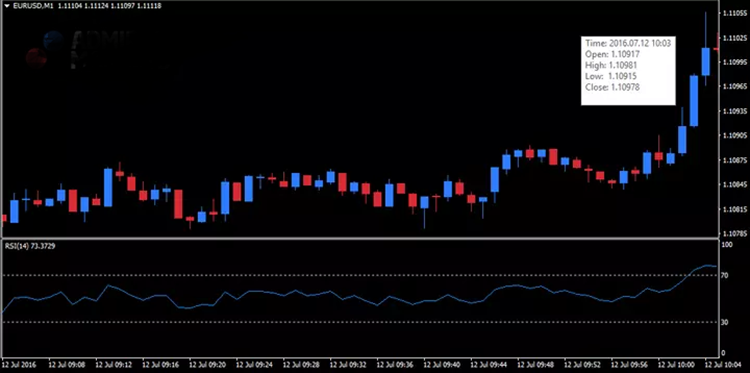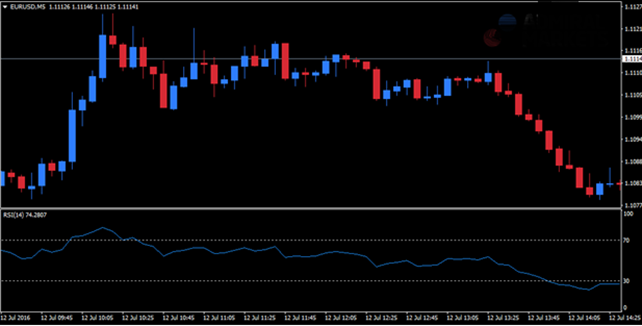
The Martingale strategy is the single most divisive factor in trading circles. One side will argue that it is one of the oldest and easiest ways to make a profit, while the other will grumble that it is one of the costliest means to learn a lesson.
With origins in binary options trading, this trading strategy is favored by investors looking for a high-risk, high-reward approach. It entails doubling the investment after each trade loss in order to recover trade losses and generate a profit. Its possibility for quick returns frequently tempts traders, but they should exercise caution because it can result in substantial losses when markets are volatile.
Let’s learn more about Martingale Strategy and why some traders prefer to include it in their trading tactics.
What is the Martingale Strategy?
The Martingale is a betting-style technique that involves doubling your position size after each loss. Specifically, it entails doubling up your trade size when you lose. Do you know how people use the phrase “double or nothing” in a betting game and then win big? This is essentially what the martingale strategy is about.
The objective here is to be able to suffer losses while knowing that the first win will overturn them all and even net you a good final profit. That’s the theory, at least.
Consider a coin flip, for a basic example. There is an equal probability that it will come out to be either heads or tails. If you bet $10 on tails but it comes up heads, you’ve lost $10. So, you try again, raising the next bet to $20. If you lose again, your losses will be doubled up to $40.
When you ultimately win, the money you make from that single win should be enough to pay all of your past losses and even generate a profit. After your initial win, you can either leave the table with a profit or gamble again with the initial bet.

You lost $150 in the first four coin flips since you doubled down your stake after each loss. But on the fifth flip, you won and received $160, which was enough money to recoup your $150 loss and even make a $10 profit.
There are only two rules to keep in mind:
- Double your bet size with each loss.
- Return to the initial bet size following a win.
Probability demonstrates that gamblers will ultimately win a bet regardless of how lopsided the odds are. The martingale strategy ignores your past loss and works by increasing the trade size. By doubling down after each losing bet, the winning bet will yield enough to cover the losses of all the previous trades plus some gains, as in the example.
The main issue with this method is obtaining enough supply of money, as it may take more than a few trades before you profit. If you run out of capital before that occurs, you will have lost all of it.
History & Origins in Gambling
Since it is a probability and betting style-based technique, it isn’t surprising that the martingale system has roots in gambling. There are two main schools of opinion as to how it came about.
Like most contemporary gambling traditions, many believe it developed in the 18th century in France. Gambling was the norm at that time; the upper class gambled with greater sums than sense, and the lower class gambled with what they could afford to live.
Since it became so prevalent, scholars began investigating the science behind the likelihood of different games. Among these researchers, French mathematician Paul Pierre Levy is credited with popularizing the martingale system for profitable betting.
The second school of thought claims the method got its name from John Henry Martindale, a London casino proprietor. John claimed to have encouraged gamblers in his casino to double down on their bets because the mathematics established that they were certain to win their money back with a small profit.
As if to support his claim and increase the martingale’s popularity, a well-known gambler named Charles De Ville Wells used the approach to convert 4,000 francs into nearly 1,000,000 francs in the casino at Monte Carlo. His remarkable success even sparked the 1891 ballad “The Man Who Broke the Bank in Monte Carlo.”
The martingale strategy became popular in roulette because it involves betting on either black or red. That is one of the reasons why the numbers 0 and 00 were included in the roulette wheel. It presented more possibilities than just black and red.
Criticism of the Martingale System
As mentioned earlier, the major criticism of the martingale system is obvious: you need an unlimited supply of money to continue doubling down your bets after each loss. What if you experience an extremely lengthy losing streak and run out of money before your first win?
Keep in mind that the size of the bet continues to expand exponentially after the initial bet. When a losing streak persists for too long, you may have to accept your compound losses and quickly exit before you have the opportunity to make up your losses.
If you truly think about it, the risk-to-reward ratio isn’t very good either. Nobody wants to lose money, whether it’s at the casino or trading stocks. So, while the martingale system appears to be flawless in theory, the fact is that increasing your losses in the hopes of a potential gain equal to your starting wager amount is not only unrealistic but also dangerous.
Lastly, the martingale strategy does not consider any additional costs involved with placing the wager. These additional fees, together with your losses, might quickly escalate into a big risk that you may not afford to manage.
Everyone has an extent to risk their capital. Using the martingale strategy for a long time can increase your likelihood of experiencing a protracted losing streak. Depending on your perspective, this may seem unappealing. Needless to say, the martingale system does have its supporters.
Using the Martingale Strategy in Trading
So, why do people apply betting game-based strategies to financial markets? This is a legitimate question, especially given the key contrasts between gambling and trade. After all, a trader can make well-informed decisions, but a gambler simply tries to beat the odds.
Nevertheless, the martingale strategy can be applied to trading as well. After all, in trading, you basically ‘bet’ on which direction the price of the underlying asset will move: up or down. A trader can choose to enter a trade with $100, just like in the original gambling method. If they experience a trade loss, they will increase the stake to $200 and attempt again. They keep doubling down on their bets until they land a successful trade. This can be effective with a 1:1 risk-reward ratio, but in trading, you can shift the risk/reward equilibrium in your favor.
By doing this, you can enhance the potential gain while maintaining the maximum loss the same as in a gambling strategy, giving you a slightly higher chance of success. Nonetheless, without enough funds to get profitable outcomes, you have to endure missed trades which can devastate your entire account, just as it would in a gambling setting.
How Martingale Strategy Works in the Stock Market?
In essence, the martingale system is utilized in situations when there is a 50/50 chance of winning or losing. As you may be aware, the stock market, or any other financial market, cannot be neatly reduced to a few simple probability calculations. It is never as straightforward as flipping a coin or placing a bet on a roulette table.
That is why, if you ever think of using the martingale strategy for the stock market, it must be tweaked slightly. Let us consider an example.
Assume you purchased $1,000 shares at $10 per share. The stock price declines by 50% over the next few days, so you purchase more shares, and this time for $2,000 at $5 per share. Supposing the stock price falls 50% from that moment, you make another $4000 purchase at $2.50. So, you own a total of 2100 shares and invested a total amount of $7000. The average price per share is $3.33 (7000/2100).
At this time, you can effectively exit the trade and profit when the price reaches $3.81 — 2100 x $3.81 = $8,001.
$8,001 – $7000 = $1001 (your original investment plus $1,001 profit).
Any price more than $3.33 indicates an approximate profit on your trade.
Of course, to emphasize, all of this is hypothetical. These scenarios rarely turn out exactly as we envision. Furthermore, there is no guarantee that the stock price will quickly return above the average price after commencing the third position.
If the stock price continues to fall while you double your investment, you may eventually run out of money to invest. As a result, you will be compelled to abandon the transaction with an immense amount of compounded losses.
How Martingale System Works in Forex Trading?

The Forex market is not naturally aligned with a simple win-or-lose decision with a fixed sum. The reason is the profit or loss of a Forex trade is unpredictable. We can set the price levels where we take profit or loss. By doing so, we limit our potential profit or loss to equal amounts.
The chart above shows a 1-minute EUR/USD chart with the RSI (Relative Strength Index) plotted underneath. RSI’s purpose is to offer us a simple entry point as well as to indicate the market’s state: if the RSI falls below 30, it indicates that it is oversold, and if it ascends beyond 70, it indicates that it is overbought.
At 10:03 a.m., the RSI increases above 70. This serves as our entry point. We sell a single lot of EUR/USD at 1.1095. We then set a 30-pip limit at 1.1065. This is where we take profit. We set a mental stop 30 pips higher, at 1.1125. Unfortunately, EUR/USD kept on increasing, and our stop was crossed at 10:15 a.m.

We consider ourselves to have lost at this point. The martingale strategy now requires us to double up. We utilize a mental stop-loss instead of an actual stop order. Why are we doing this? Because it would be foolish to close one deal and then reopen another twice the size. We open a new trade with the same size as the previous deal to double up.
We then sell an additional lot at 1.1125. We set a new mental stop 30 pips higher at 1.1155. To close both deals, we replace the original limit order with a new one. This is 30 pips under our new trade, which is at 1.1095. We initially sold one lot for 1.1095, then another at 1.1125. This provides us with an average entrance point of 1.1110.
We’re fortunate this time, as the market falls below our limit within the next couple of hours. At 1:55 p.m., we close at 1.1095. We closed 15 pips lower than our average entry point. One lot of EUR/USD is worth $10 per pip. As a result, we make 15 pips multiplied by $10 per pip, for a total of $150. This is a simple instance of how we might use a martingale strategy.
It worked out well in this particular instance, but can you think of a scenario in which you have a string of bad trades in a row? It’s a unique possibility. Martingale system’s stick to your guns attitude may be effective in situations with an increased likelihood of return to the mean. However, it is particularly dangerous in a trending market. The technique always runs the risk of accumulating a significant loss, forcing you out of the market.
One disadvantage of the martingale trading strategy is that it involves gambling with your losses, which is generally regarded as breaking the norms of proper money management. It’s fascinating to compare it to an anti-martingale system or reverse martingale (a tactic commonly used by trend-following traders).
The latter entails keeping your position size while you lose and expanding it after you start to earn as a trend builds.
Conclusion
Your trading success is primarily determined by the efficacy of your trading plan. There are a multitude of trading strategies available. It’s more vital than ever to grasp their benefits and drawbacks so you can decide whether they’re worth employing.
In the case of the martingale trading strategy, the severe disadvantages outweigh any potential advantages. The martingale strategy can help traders make some profit, but only if they employ it for short periods. As such, the method is unlikely to make you wealthy. Overall, success with this method is primarily dependent on chance and access to an endless supply of money.
When implementing the martingale strategy, it is critical to monitor your bet size and avoid letting it spiral out of control. Losses can quickly accumulate and become unmanageable, resulting in far more money being lost than anticipated. This is most likely why Martindale popularized the strategy; he actually owned the casino, after all. As a result, utilizing the martingale strategy is usually unwise. The risks far outweigh the benefits, and it takes a significant amount of wealth to weather extended losing streaks.


